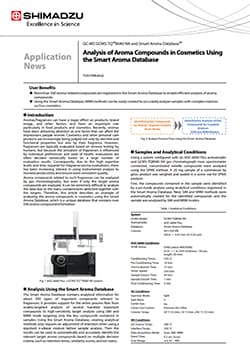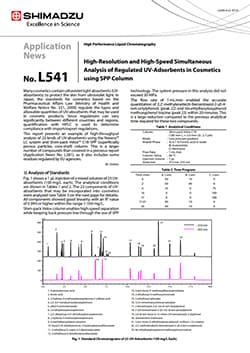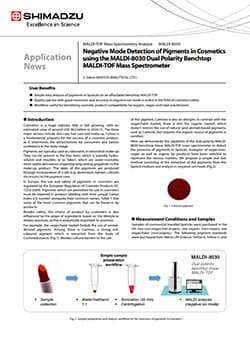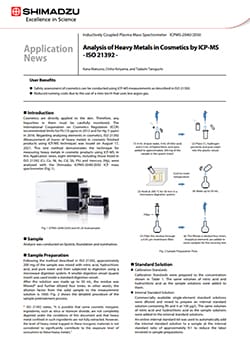Cosmetics & Personal Care Products
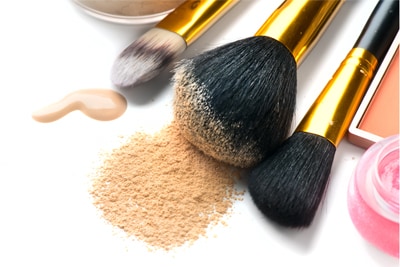
Cosmetics and personal care products have always played a big part in our lives, but the environment surrounding them has been changing recently. In addition to serving their original aesthetic purpose, cosmetics are increasingly required to be environmentally friendly and impart no adverse effects on animals during development.
Shimadzu offers comprehensive solutions for cosmetic and personal care product testing, helping you to prove both cosmetic quality and safety with clear numerical data. We provide a wide range of analysis methods useful for cosmetic development, quality control, product improvement, and regulatory testing. Our applications cover pigment analysis, complex flavor and fragrance classification, particle size analysis of emulsions, non-animal skin sensitization testing methods, and identifying PFAS/PFOS in cosmetic products, etc. Learn more about these solutions below.
Featured Applications
Analysis of Aroma Compounds in Cosmetics Using the Smart Aroma Database
Aromas/fragrances can have a major effect on products, brand image, and other factors, and have an important role particularly in food products and cosmetics. Recently, aromas have been attracting attention as one factor that can affect the impressions people receive. Cosmetics and other personal care products are increasingly being judged not only by skin feel and functional properties but also by their fragrance. However, fragrances are typically evaluated based on sensory testing by humans, but because the sensation of fragrances is influenced by individual preferences and state of health, evaluations are often decided statistically based on a large number of evaluation results. Consequently, due to the high expertise levels and time required for fragrance/aroma evaluations, there has been increasing interest in using instrumental analysis to increase productivity and ensure more consistent quality. Aroma compounds related to such fragrances can be analyzed by gas chromatography, but even if only the target aroma compounds are analyzed, it can be extremely difficult to analyze the data due to the many contaminants detected together with the targets. Therefore, this article describes an example of analyzing the aroma compounds in cosmetics using the Smart Aroma Database, which is a unique database that contains over 500 aroma compound information.
High-Resolution and High-Speed Simultaneous Analysis of Regulated UV-Adsorbents in Cosmetics using SPP Column
Many cosmetics contain ultraviolet light absorbents (UV-absorbents) to protect the skin from ultraviolet light. In Japan, the standards for cosmetics based on the Pharmaceutical Affairs Law (Ministry of Health and Welfare Notice No. 331, 2000) regulate the types and allowable quantities of UV-absorbents that may be used in cosmetic products. Since regulations can vary significantly between different countries and regions, quantification with HPLC is used to determine compliance with import/export regulations. This report presents an example of high-throughput analysis of 23 kinds of UV-absorbents using the Nexera™ LC system and Shim-pack Velox™ C18 SPP (superficially porous particles, core-shell) column. This is a larger number of compounds than covered in a previous report (Application News No. L381), as it also includes some residues regulated by EU agencies. .
Negative Mode Detection of Pigments in Cosmetics using the MALDI-8030 Dual Polarity Benchtop MALDI-TOF Mass Spectrometer
Cosmetics is a huge industry that is still growing, with an estimated value of around USD 863 billion in 2024 [1]. The three major sectors include skin care, hair care and make-up. Color is a fundamental property for the success of a cosmetic product, as it determines the attractiveness for consumers and boosts confidence in the body image. Here, we demonstrate the capability of the dual polarity MALDI8030 benchtop linear MALDI-TOF mass spectrometer to detect the presence of pigments in lipsticks. Examples of vegan/nonvegan as well as organic lip products have been selected to represent the various markets. We propose a simple and fast method consisting of the extraction of the pigments from the lipstick medium and analysis in negative ion mode.
Analysis of Heavy Metals in Cosmetics by ICP-MS -ISO 21392 -
Cosmetics are directly applied to the skin. Therefore, any Impurities in them must be carefully monitored. The International Cooperation on Cosmetics Regulation (ICCR) recommended limits for Pb (10 ppm) in 2013 and for Hg (1 ppm) in 2016. Regarding analyzing elements in cosmetics, ISO 21392 (Measurement of traces of heavy metals in cosmetic finished products using ICP/MS technique) was issued on August 17, 2021. This test method demonstrates the technique for measuring heavy metals in cosmetic products using ICP-MS. In this Application news, eight elements, including those listed in ISO 21392 (Cr, Co, Ni, As, Cd, Sb, Pb) and mercury (Hg), were analyzed with the Shimadzu ICPMS-2040/2050 ICP mass spectrometer.



